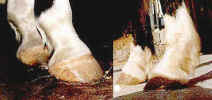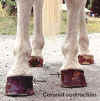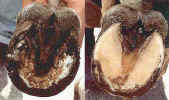
Strasser case studies--Barushka
(Click on small, "thumbnail" photos to see larger versions)
Barushka wouldn’t let anyone touch her, and had gone through so much pain with farriers and vets the horse was virtually psychotic. It took two months before she would trust them again.
Everything had been tried. Despite being nerved, the horse was still lame. Loose wall on the white hind left hoof is clearly visible. The decay went almost up to the coronet band.
Turned out extremely well; horn grew back.
5 months after beginning of treatment, she could be ridden again.
Barushka—fores, before and after
Barushka, hinds, before and after
Barushka, before and after; trim details
Strasser case studies--Charlotte
Charlotte was rescued from a dealer’s yard in Luxembourg, where she was waiting to be sent to the slaughter house. The new owner was willing to put her down humanely at home if the vet felt it was hopeless, but he didn’t think so. The pony was emaciated and had “Egyptian slipper” feet from years of neglect. Her new owner’s farrier did an initial trim, but he and the vet were both afraid they were in over their heads.
A friend of the owner found out about Dr. Strasser from my web site. They called Dr. Strasser, who told them to bring the pony to her clinic immediately. They hauled the pony 6-1/2 hours from Luxembourg to Dr. Strasser’s clinic on May 11, 1999.
A second set of photos were taken on June 4, 1999. Dr. Strasser feels the joints being twisted from years of poor hoof balancing will be harder and take longer to fix than the feet themselves.
Early July, 1999 update--the pony was pulling on the leadline, wanting her handlers to walk faster. She has been happy at the clinic, a huge area (former indoor riding arena) covered in rubber mats, where she can socialize with other horses. She has a best friend, another pony, and they are wandering around together a lot.
Charlotte—fores, May 11, 1999
NOTE: Hairlines were almost horizontal, rather than sloping down rearwards at an ideal
angle of 30 degrees. This causes the tip of the coffin bone to stab down into the sole.
Charlotte—left fore, May 11, 1999
Charlotte, right fore, May 11, 1999
Note extreme contraction!
Bottom photo shows first trim by Dr. Strasser
Charlotte, right fore, May 11, 1999
First trim by Dr. Strasser
Charlotte, hinds, May 11, 1999--"Before"
Note high heels, still not enough slope to hairline.
Charlotte, hind soles, May 11, 1999
…And “After”
Charlotte, left fore, June 4, 1999
Hairline more sloped. More compact shape from front to back, and wider heels.
More taken off back of foot from the bottom than the front. Toes backed up.
Charlotte, right fore, June 4, 1999
AGAIN--note how the trim often involves taking more off the back than the front.
Charlotte, left hind, June 4, 1999
Charlotte, right hind, June 4, 1999
Strasser Case Studies--Giacomo
Giacomo was an 8 yr. old Welsh/Mt. Gelding. His first laminitis was grass founder. He had 4 years of recurrent founder. His coffin bone was too steep because his heels were too long. He had deformed hooves, and the toe laminar corium was totally overstressed. Every time he got out on grass, he foundered.
He had high heels, long toe, chronic laminitis, and rotation. He had been treated with orthopedic shoes, acupuncture, homeopathics, etc., for 4 years since his first grass founder. None of this helped, because the deformed hooves and incorrect angles were not addressed.
After 3 months, his hooves were very good and he could be ridden again. Admitted 5-19-97; released 8-23-97
Giacomo, fores, before and after:
Notice how a great deal was taken off the heels, but the sole was taken down much less in toe area. The heels spread considerably. Toe wall was kept backed up into the white line.
Strasser case studies--Indiana Jones
Indiana Jones' hooves had very poor horn quality. After his shoes were removed, everything mushed apart. He got rotation and descension of the coffin bones because the walls could no longer support his coffin bones. His heels were very high and forward to past the middle of the frog, and his bars were laying down on his soles.
After trimming, he went along very well; he could move better after the trim than ever before.
Unfortunately, after he was released to go home, the horse went back to box stall keeping. He got one disease after another (respiratory, etc.) After a while, he also got stocked-up legs and constant colds. He was eventually put down.
One moral of this story: once a box stall horse is given natural living conditions and gets used to them, he cannot survive this kind of captivity anymore.
Indiana Jones fores, “Before”
Note high, under-run heels and extreme heel contraction.
Indiana Jones—“After”
Note how much heels have spread and the footprint has become rounder.
More taken off in back than in front.
Strasser Case Studies--Medici
Medici was an 18 yr.old Warmblood mare. She had always been shod, and had extremely bad metabolic disturbances.
She foundered, and was treated with heavy orthopedic shoeing and toe resection, which didn’t help. She had various lameness problems, poor liver values, eczema, and coat problems.
While in clinic (3 months) all metabolic problems disappeared completely (proof that the lack of circulation of the corium, and as such the backing up of excess protein in system because the protein could not be utilized making more horn, resulted in poor kidney and liver function.)
Horse is being ridden again.
Treated 4-7-97 to 11-8-97, and released 6-28-97 from clinic—also dates of photos.
Toe broken out in "before" photo—not resected.
High heels, contracted heels, dry and inelastic hooves, LF 30 degree rotation, also dropped coffin bone; chronic laminitis, and metabolic problems because of not utilizing enough protein due to contraction and shoeing.
Medici, 4-7-97 and 6-28-97
Note: hairlines sloping more, shorter from front to back, greatly improved horn quality.
Medici, 6-28-97
Strasser Case Studies--Nobby
Originally he foundered in one foot, and then was treated with orthopedic shoes and 3 months’ box rest. This resulted in other foot getting laminitis due to overstressing; other foot was then put in a cast and an orthopedic shoe. Then his first foot, originally his bad one, got laminitis again. He had a cast on for 3 months again, and was treated with rivanol, orthopedic shoes, etc. His coronet band had swelled up, etc., and the vet said horse should be put down because nothing could be done on him again.
Taken to Strasser clinic 11-17-94. Found coffin bone too steep, and protrusion was almost at the tip of frog. When Dr. Strasser got him, they couldn’t even see where the joints were, and didn’t know what the swelling was or what was going on inside it.
Nobby went home 4-11-95. Foot used normally, horse moving normally, but limping a bit. Would run, and felt good; but it took about 8 months total until the horse was completely sound again.
Treated without charge--Dr. Strasser didn’t know if this would work out, and the owner had very limited finances.
"Before"
lst trim
4 months later—using foot normally again. Completely sound in 8 months.
....There IS life after sole penetration!
Strasser case studies--Pete
Pete, a Welsh/Arab gelding, was 23 years old in 1998. The owner was told that he couldn’t stand up to hard use, or graze much, without foundering. He failed flexion tests, but was not actually diagnosed lame. The owner was advised to retire him because he had to be whipped to go faster than a walk. He had a short, choppy gait, and was walking toe-heel.
June13, 1998—Dr. Strasser did first trim. She found severe muscle tension in shoulders, rotation, heat in fores, white line separation in fronts, and coronet contraction in both fores.
Last trim, 7-13-98 by Dr. Strasser. Sabine Kells took over his trimming. He began to be ridden lightly on soft ground, and moved well right after his first trim by Dr. Strasser.
9-23-99, he placed second in a weekend show, and an extended trot and canter turned into a gallop.
October—doing well jumping him.
Dec 11—ridden in show musical ride, long, easy strides, jumping fine, tail swinging freely.
March 99—sold because he had become too "hot" for his rider!
Pete—before and after

Pete—before.

Pete—before and after
Strasser case studies--Resi
Resi, a donkey, was supposedly incurable. No one knew what to do with her hooves, and it was considered an incurable deformation. They thought there was nothing that could be done, because the hooves just grew this way as a result of supposed joint deformation. (Nobody knew why the joints and legs were deformed this way, but they suspected hoof weakness, long tendons, etc.)
Resi would only lie down at home, not stand up anymore; there were lots of bed sores on her.
At Dr. Strasser's clinic, Resi's hooves were finally trimmed properly. It took several men to hold her up during the trim. After the trim, the donkey walked away, and the owner was in tears. Dr. Strasser kept Resi for 4 weeks because the joint deformations caused by the hooves had to be re-adapted to the newly rebalanced hooves. She moved very sore for a while after the initial good start because of inflammation in the joints. Eventually, the joints wore into a more correct alignment with continued correct hoof trimming.
Fine after 4 weeks; no more problems.
Resi--before--3-2-95
Resi—before
Above—fores. Below—hinds.
(She was actually walking on the backs of her heels before Dr. Strasser trimmed her. The ground plane of the hoof was so small and far ahead of the bone column that she was forced to rock back onto the backs of her heels.)
Resi, 4 weeks later
Strasser case studies--Tieri
Tieri had a “contracted flexor tendon” (a congenital deformation), and was given to Dr. Strasser as a yearling. Presently Tieri is a sound riding horse.
Strasser case studies--Willow
Willow was a 5-year-old Curly who was to be put down because of mutliple abscesses after getting shoes pulled for the winter. She had contracted, high heels and rotation. Sabine Kells got her sound in 10 months.
Willow, fronts "Before" and "After"
Contact info:
Dr. vet. med. Hiltrud Strasser
ESHOP GmbH
Blaihofstr. 42/1
72074 Tübingen
Germany
Tel/FAX: (011) 49-7071-87572
Hufklinik@t-online.de
www.hufklinik.de (Presently only in German; an English version may be available later.)
www.strasserhoofcare.org (Official N. American clinic registration site; in English.)
Sabine Kells
ESHOP Canada
PO Box 44
Qualicum Beach, BC V9K 1S7, Canada
Dr. Strasser's books are available through The Horse's Hoof Magazine:
www.TheHorsesHoof.com (Online ordering; credit cards accepted.)
Textbook Available....
"The Hoofcare Specialist’s Handbook: Hoof Orthopedics and Holistic Lameness Rehabilitation," by Hiltrud Strasser, DVM, and Sabine Kells. Over 800 pages. The textbook for the Strasser hoofcare specialist course. For ordering info, Click HERE
Dr. Strasser has recently been nominated for the American Farriers Journal International Veterinarian's Hall of Fame; Class of 2001 by W. Robert Cook F.R.C.V.S., PhD., Professor of Surgery Emeritus, Tufts University, School of Veterinary Medicine--drwrcook@aol.com He has also written an open letter to veterinarians about her work.
Click here to see Dr. Cook's endorsements of Dr. Strasser
Click here for this page with full-sized photos
Back to Gretchen Fathauer's home page--Table of Contents
Copyright by Gretchen Fathauer, 2015. All rights reserved.